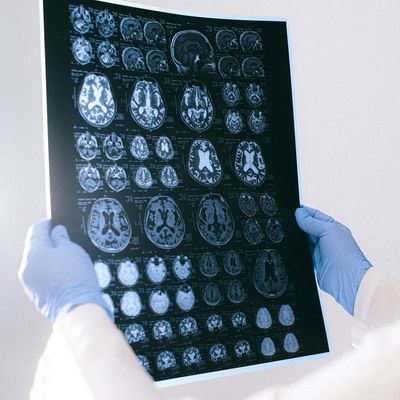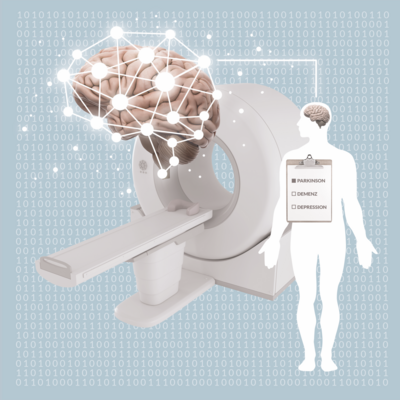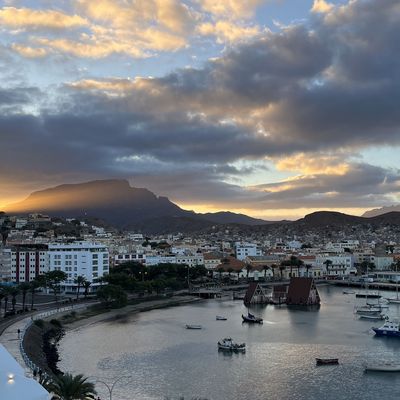Expedition to the northernmost settlement in the world

Can neural networks be used to better understand changes in the ozone layer and thus predict future climate more quickly? To find out, Helge Mohn traveled to the Arctic. Those who do their doctorate at MarDATA, like him, can go on field trips and explore the world of the oceans together with researchers from a wide range of disciplines.
Preparations began with the polar bear course. What should you do if you spot one of these 990-pound animals on the horizon, trudging over the ice? (Turn around, try not to draw attention to yourself.) What should you do if the bear gets dangerously close? (Fire a flare.) And in an extreme emergency? (Shoot.) Then it was time for Helge Mohn to pick up supplies from the storehouse at the Alfred Wegener Institute for Polar and Marine Research (AWI). Clothing and a sleeping bag suitable for minus 30 degrees Celsius, snowshoes, and outdoor overalls as a fourth layer for working in the icy Arctic wind.
At the end of February, Mohn headed out on an expedition to Spitsbergen, taking a light aircraft to the research station in the world’s northernmost settlement, situated at 79 degrees north: Ny-Ålesund. “I was pretty excited,” says Mohn. Four weeks, 60 people from 18 countries. Every six hours, Mohn used a helium balloon to measure atmospheric data before processing the data on a laptop; he also helped other teams to lash tethered balloons to the ice so that they could take air measurements. There were games of hockey and cards in the evenings and a communal dinner in the research bar on Saturdays. And all the time, discussions about how the climate is changing and what evidence the teams were seeing in the Arctic. Research in the field, for real. “I’ve never felt what I’m doing my work for so directly before,” says Mohn. “It was fantastic.”
A neural network should reveal more about the climate of the future
Since 2020, Helge Mohn has been a doctoral student at the MarDATA Helmholtz School for Marine Data Science, a graduate school with a sophisticated study program supported by GEOMAR Helmholtz Centre for Ocean Research Kiel, the AWI, Kiel University, the University of Bremen, and Jacobs University in Bremen. The School was established in 2019 in cooperation with the Helmholtz Information and Data Science Academy (HIDA), an initiative of the Helmholtz Association under whose umbrella six data science schools have been set up across Germany.
Doctoral student Helge Mohn had already taken an interest in data science when he studied for his degree in aerospace engineering, majoring in computer science, in Berlin. In his master’s thesis, he explored the question of whether artificial intelligence (AI) can be used to better understand changes in the atmosphere so that future climate trends can be predicted more quickly. His conclusion? Yes, it can. Now Mohn is using complex data about changes in the ozone layer in the stratosphere to train a neural network – so that AI can tell him more about the climate of the future. “When I realized that I could participate in expeditions here at MarDATA myself and make a practical contribution to climate research, my mind was instantly made up,” says Mohn.
Arne Biastoch is pleased. That reaction was exactly what he had hoped for: “MarDATA wants to attract data scientists with very engaging, exciting topics,” the oceanographer at GEOMAR and spokesperson for the School explains. “Climate research, the underwater world, biology, and the feeling of playing a part in exploring the Earth system – that’s what’s special about our School.” It has long been clear that the scientific disciplines connected with studying the oceans – from oceanography, marine biology, and meteorology all the way to the geosciences – are approaching their limits as far as traditional methods of analysis and mathematical models are concerned. By using satellites, measurements recorded by ships, and autonomous robotic systems floating freely in the ocean, terabits of data about our seas are now being collected all around the world – from salinity, to underwater icequakes and earthquakes, to currents and data about weather above the ocean’s surface. New methods are needed to capture all this information and use it effectively. “We’re certain that there are many hidden treasures in the data,” Biastoch says. “To do that, we need specialists who can use data science methods to comb through this data and uncover connections that we can’t identify using traditional methods.”
We are building something that does not exist anywhere else in the world
That is why, when the Helmholtz Association encouraged its Centers to establish graduate schools at the intersection between discipline-specific research and data science four years ago and invited applications for funding, Biastoch was on board right away. “This was a completely new field for us, but we seized the opportunity.” The idea quickly took shape – we would bring together all the marine science disciplines, however diverse, and build something that doesn’t exist anywhere else in the world: marine data science. Biastoch: “When we started discussions with the computer science experts, even we professors realized that this would be pioneering work.” The computer scientists had little understanding of what exactly ocean science actually entailed. The ocean scientists, on the other hand, had only imprecise, sometimes unrealistic notions of what data science could deliver using innovative AI methods.

Together for the oceans - the institutions behind MarDATA
MarDATA has been up and running since June 2019. Its approach is to provide a broad education that ties together fields of study as diverse as physical oceanography and marine biology in order to train graduates in all aspects of Earth system science. “As a result, the entire field of applications is open to them in which to pursue their careers,” explains MarDATA coordinator Enno Prigge. In block courses, the doctoral students get an overview of specialized scientific disciplines such as geobiochemistry, marine biology, or physical oceanography. At the same time, they receive extensive data science training: ocean modeling, introduction to databases, working with neural networks, or data visualization. “Even computer scientists aren’t trained to the same level in all fields,” notes Prigge. Someone who studied data security as an undergraduate is far from being a professional in machine learning. Someone who is familiar with databases is far from being an expert in complicated statistics.
Two cohorts are now working on their doctorates at the School in northern Germany. There are 33 doctoral students in total, and the goal is to increase this number to 40 by the end of 2022. It is worth noting that, in contrast to the Helmholtz Association’s five other data science schools, half of MarDATA’s doctoral students are female. And since HIDA, as the umbrella organization, has been marketing the schools internationally, the number of candidates has increased fivefold. While 81 applied for 20 advertised project positions in the first year, 447 applications were submitted in the second. In addition to good grades and, of course, solid knowledge in the field of information and data science, the crucial factor for selection is motivation: “In other words, the willingness to venture into completely unknown territory and to explore the marine sciences with a curious mind,” as Biastoch puts it. “We also want candidates to have a clear interest in a specific topic.” The spectrum offered is broad, ranging from climate modeling using machine learning methods to predicting the development of maritime resources through mapping the seafloor.
Step-by-step analysis instead of theory development and experimentation
Helge Mohn’s passion for researching the atmosphere over the ocean helped him to secure his place. Now he enjoys the stimulating collaboration with the teams of marine and data scientists. “Elsewhere, data science is often seen only as an application discipline,” says Mohn. “Here, natural scientists recognize that our empirical approach is scientific too.” Step-by-step analysis instead of theory development and experimentation. Together with his supervisors in the fields of climate research and computer science, he is now investigating various questions: What further information could AI evaluate in order to improve our understanding of changes in the ozone layer? In addition to chemical data, how about incorporating information about the intensity of sunlight – i.e., how much energy is available in the air at any given time? What does the data reveal then?
MarDATA follows the principle of two-pronged supervision, where all doctoral students have one supervisor from the data science field and one from the specialized scientific discipline relating to their topic – one of the principal investigators (PIs). The PIs select the candidates themselves, support them through the three-year doctoral period, and decide together at which institute the doctoral student will be based. At the weekly meetings with coordinator Enno Prigge and the other doctoral students, there’s time for questions: I’d like to take another course in modeling methods, is there anything available? I’m having problems with data visualization, does anyone have any ideas?
Currently, the network of links with other marine science disciplines around the world is also being strengthened, with international scientists sitting on the School’s advisory board.
“By having a foothold in the industry, we might even be able to develop joint projects in the long term. For instance, we could collect data in order to optimize the efficiency of ship navigation across the oceans in real time”
Enno Prigge, Coordinator MarDATA
Coordinator Enno Prigge is now putting out feelers to the maritime industry too. Although MarDATA’s primary goal is to train the next generation of topflight scientists, one thing is clear: Not all of the School’s graduates will find a permanent position in academia. And an academic career with frequent changes of location and long stays abroad doesn’t suit everyone. “By having a foothold in the industry, we might even be able to develop joint projects in the long term. For instance, we could collect data in order to optimize the efficiency of ship navigation across the oceans in real time,” says Prigge. “Companies are very interested in collaborations.” After all, the fields of application are similar, from robotics to modeling.
Petra Mahnke is the Managing Director and Vice Chairwoman of the German Association for Maritime Technology (GMT), which represents the interests of companies and research institutions active in the field of marine technology. “The marine technology sector develops, produces, and uses technologies for the exploration, protection, and sustainable exploitation of the oceans,” says Mahnke. “This makes it an essential part of the maritime industry.” But she explains that more research, more scientific data, is needed so that the health of the oceans can be analyzed even more effectively. Is the seafloor in good shape? What are the meteorological conditions above the oceans? What can we discover about currents, temperature, salinity, and the physical state of coastal zones, or the behavior of waves?
Satellites, ships, offshore facilities and monitoring systems permanently collect new data
Such insights are fundamental to protecting the oceans and using them sustainably. For example, in order to identify locations for offshore wind turbines, exploit natural resources, and obtain information about areas of the sea for use as shipping lanes and for underwater installations. With satellites, ships, offshore facilities, and monitoring systems constantly collecting new data, and the entire industry becoming increasingly digitalized, new fields of application are emerging for marine technology companies. “Consequently, the industry has a growing need for marine data scientists,” notes Mahnke. “To analyze this data, we need precisely those kinds of interface specialists who can evaluate and process data to produce valid, comparable results and make their findings available to the industry.”
MarDATA is already planning a major event with companies from the maritime industry. Shipping companies, shipbuilders, and giants of the shipping industry like Thyssenkrupp will be there. Helge Mohn hasn’t yet decided between industry and academia. “Whatever happens, I want to work in an interdisciplinary environment and develop technical innovations that really do something to advance climate research.” Maybe he’ll even head up a team composed of people from the natural sciences and engineering one day. As Mohn says, “Ultimately, what matters to me is that my work is exciting and inspiring.”
Author: Anja Dilk











